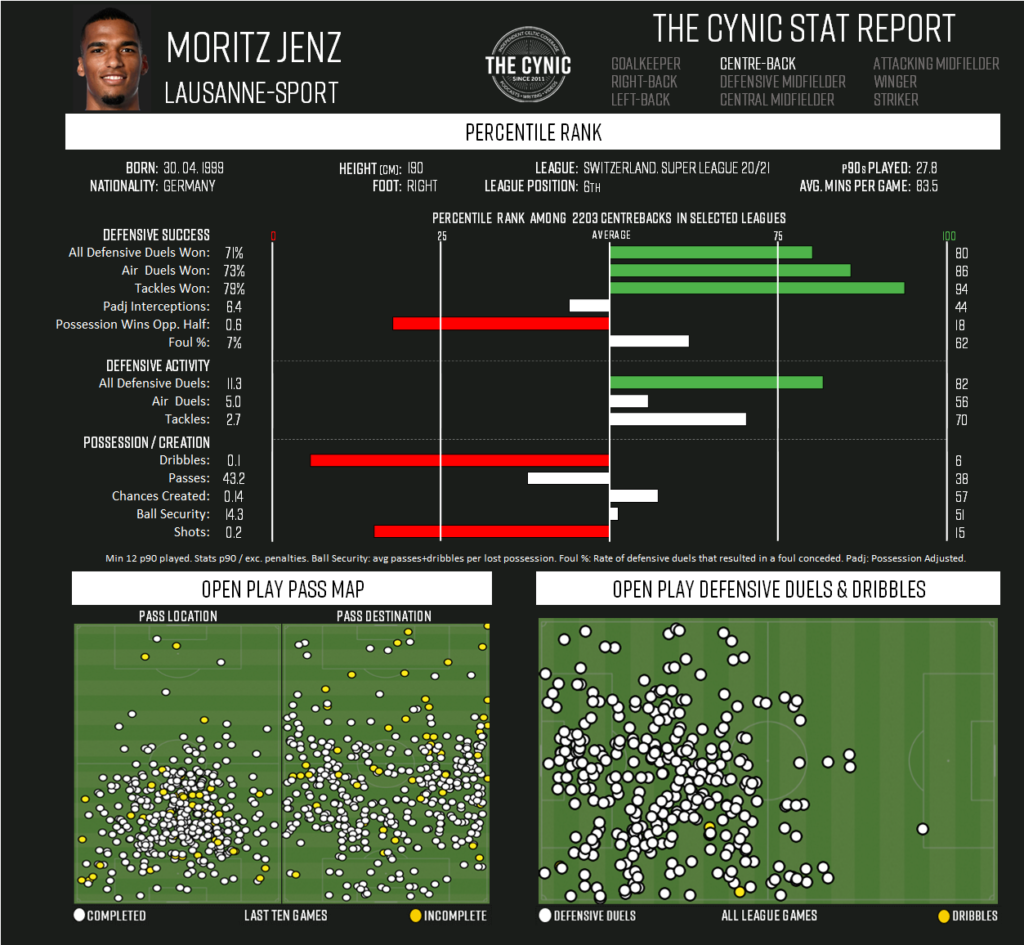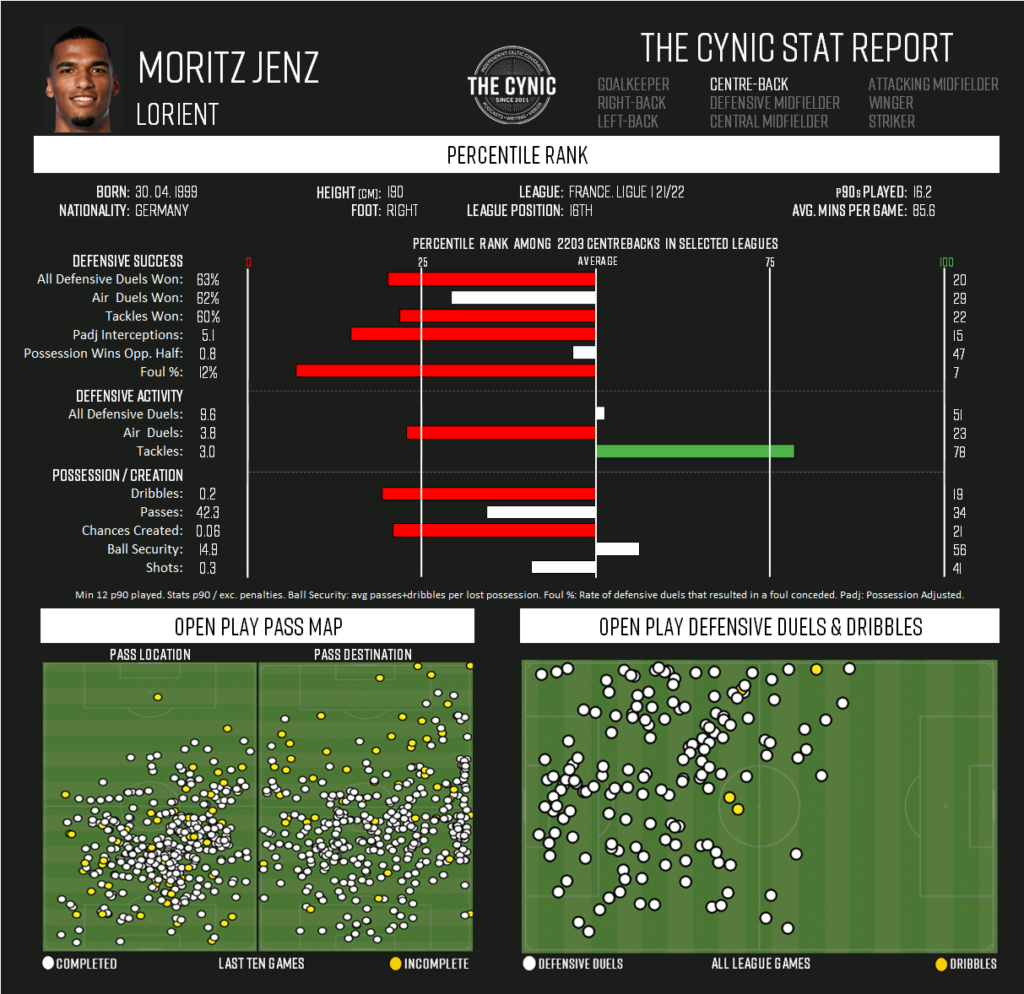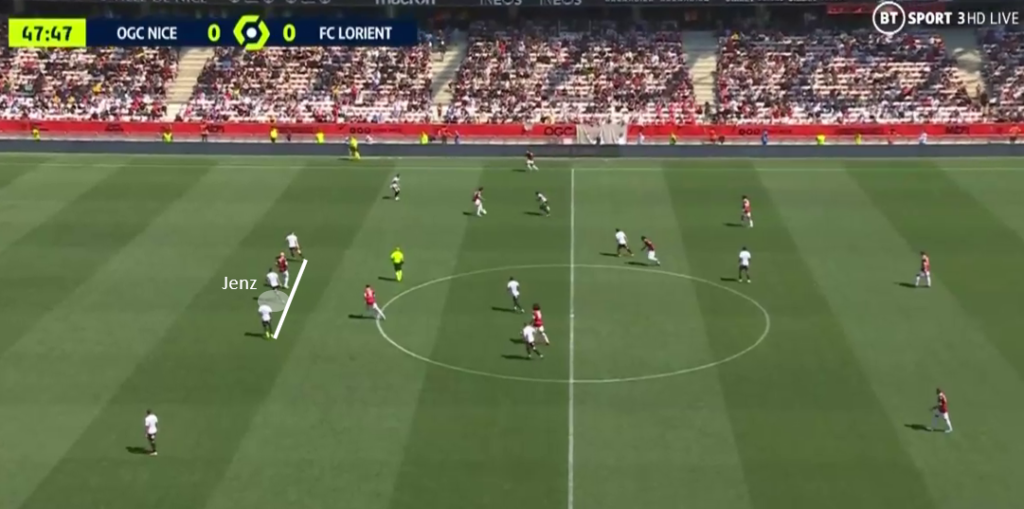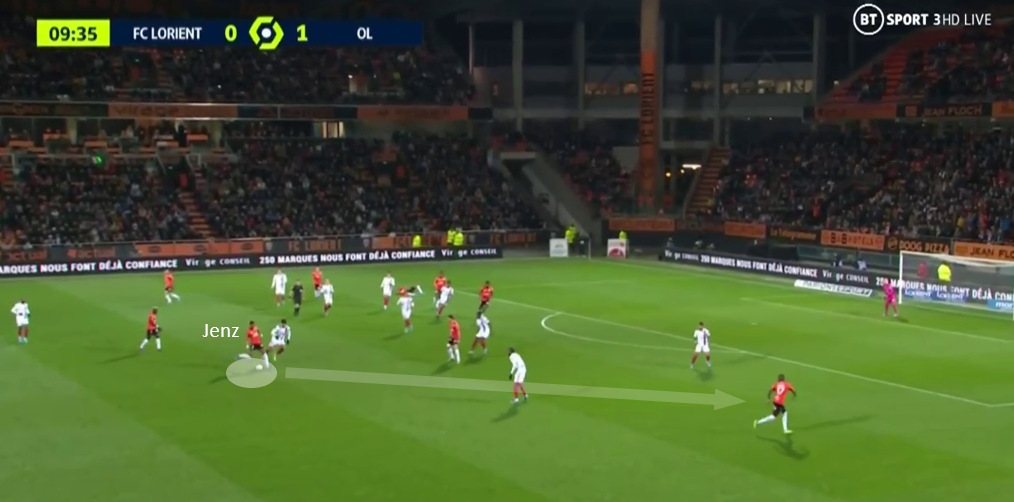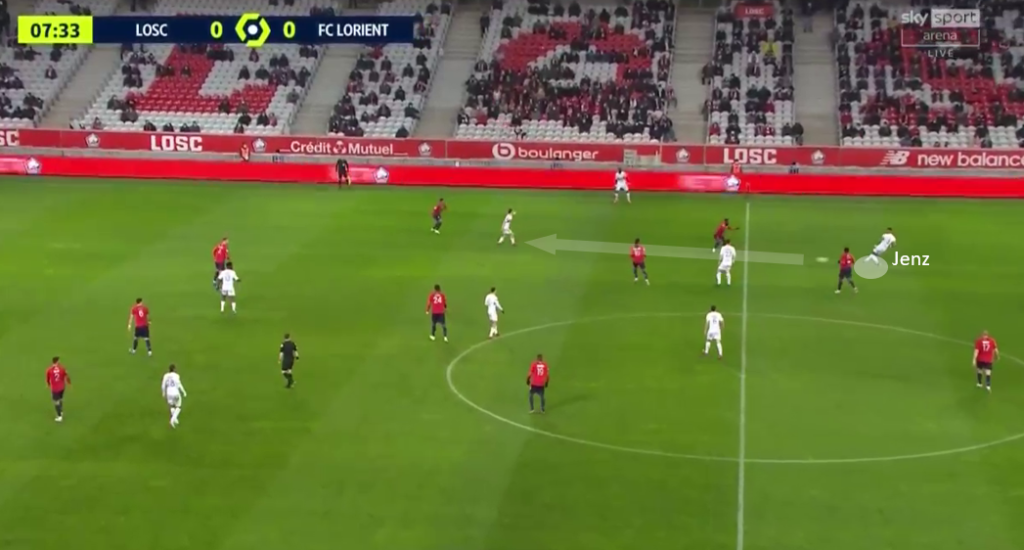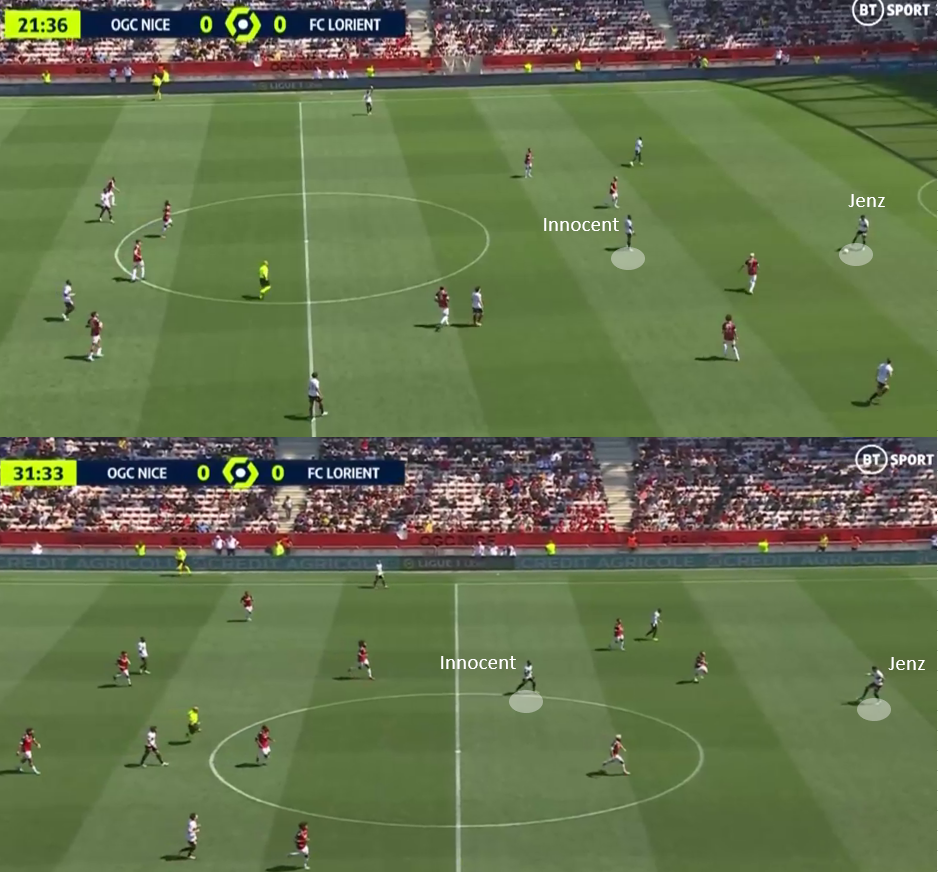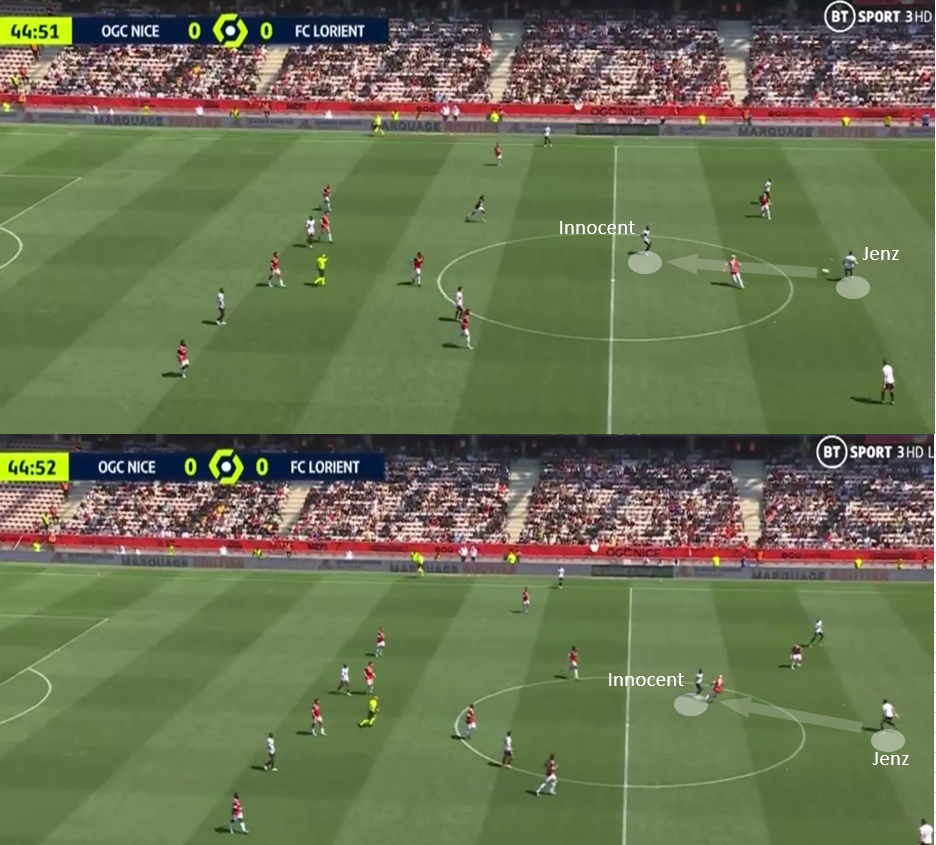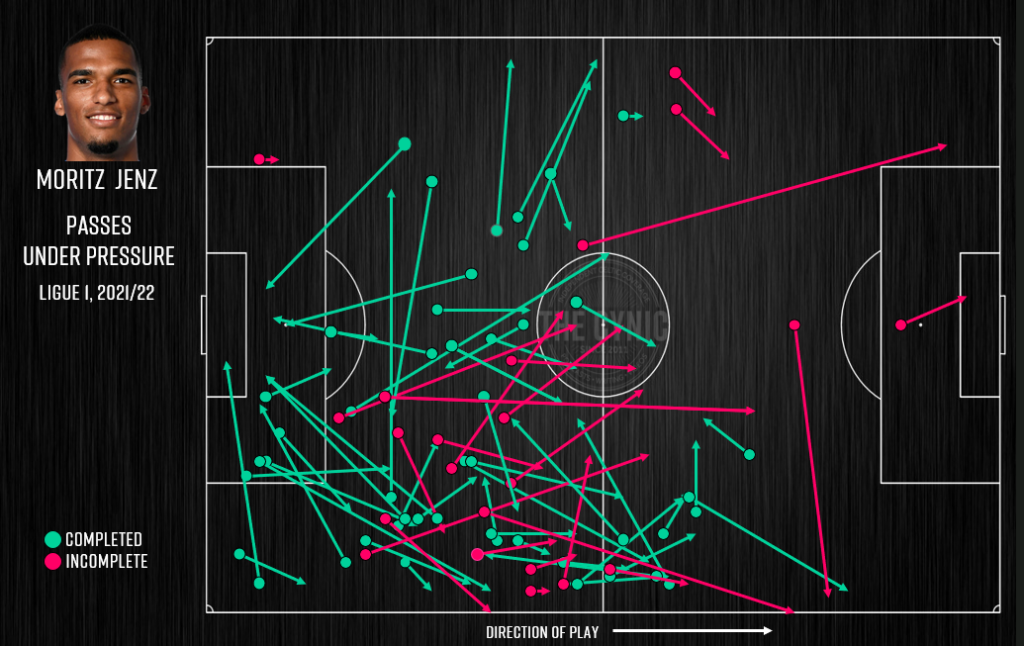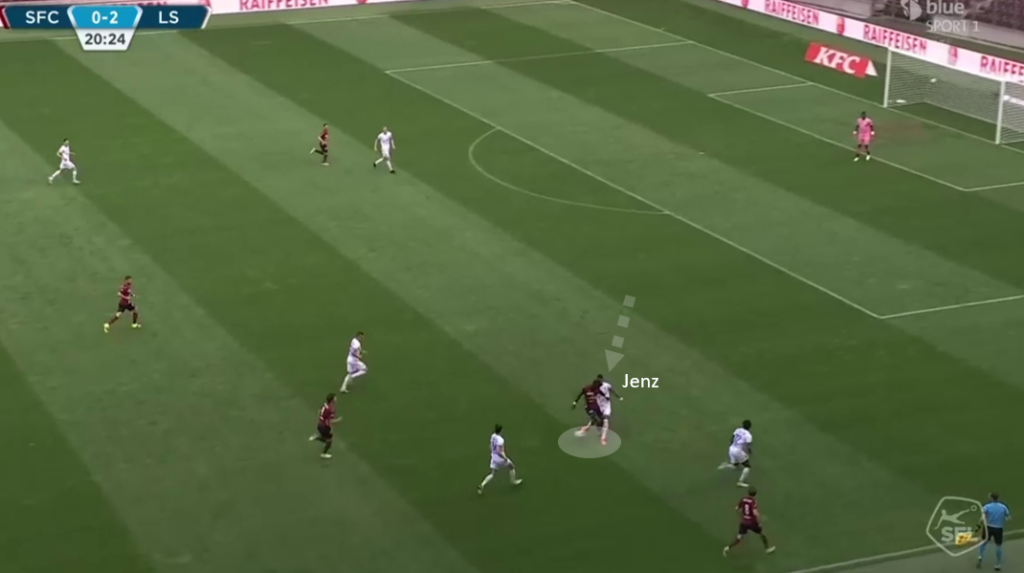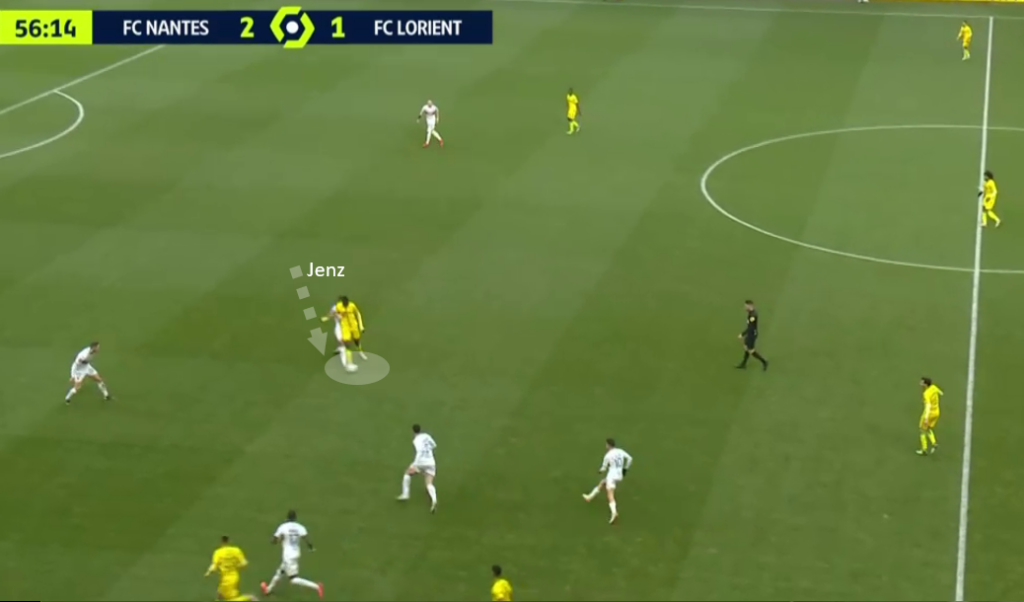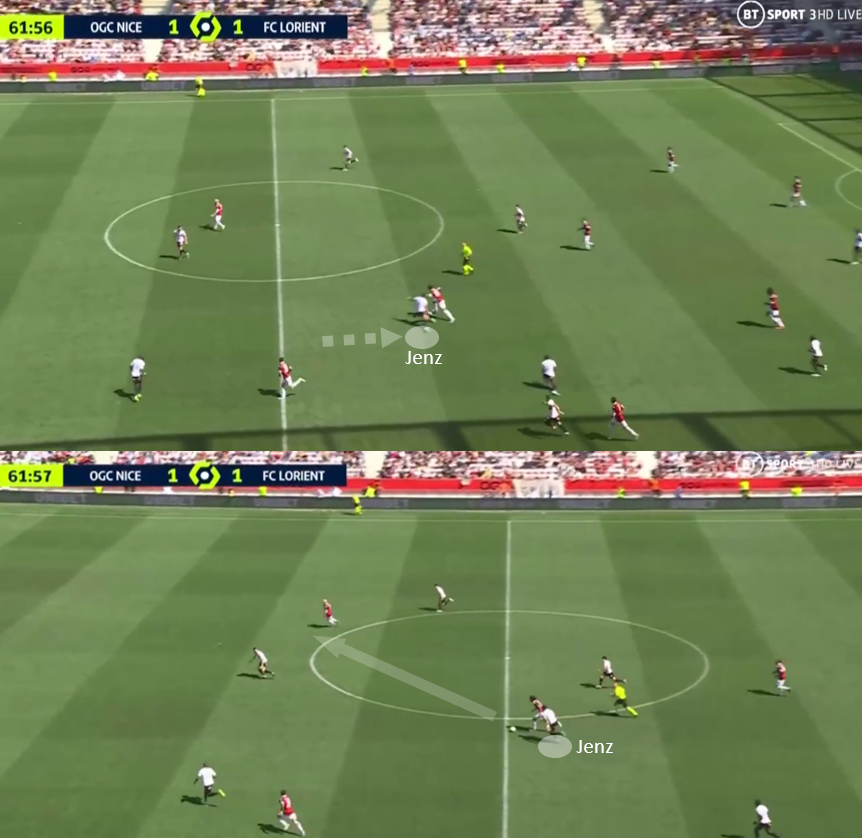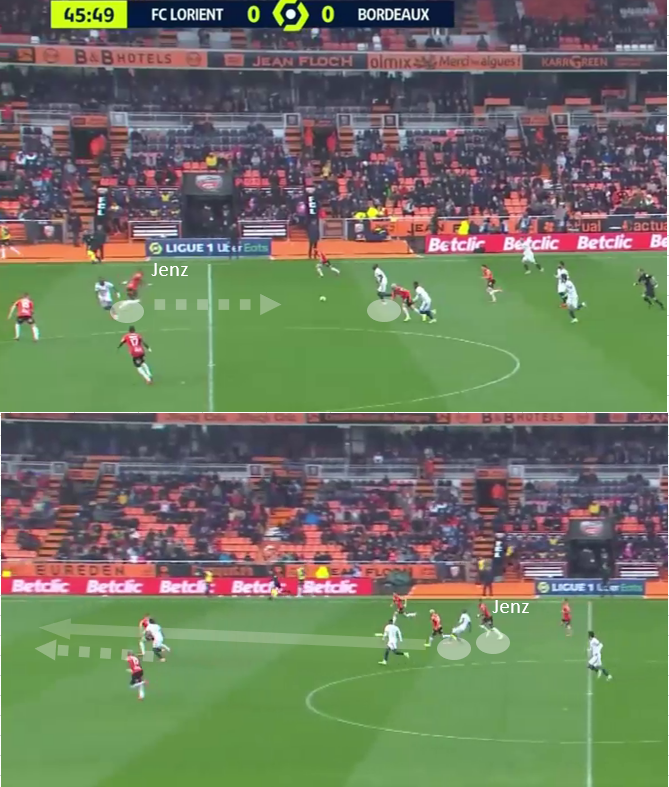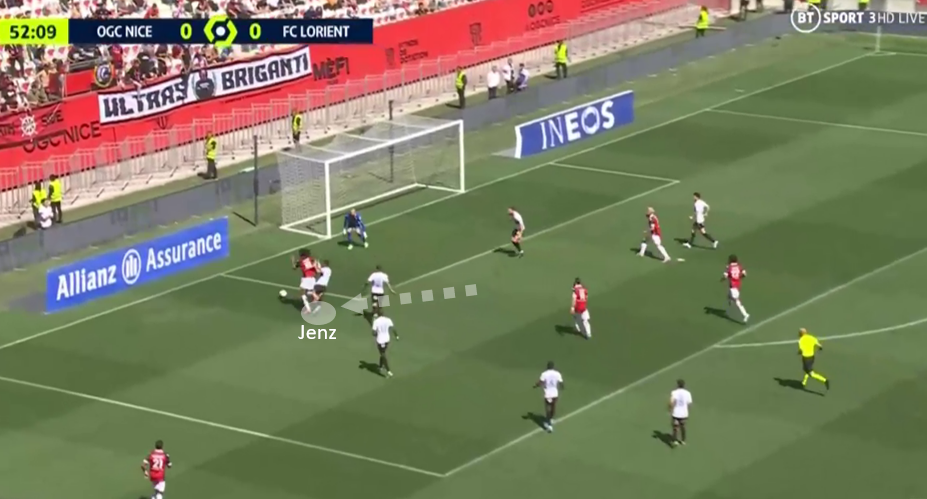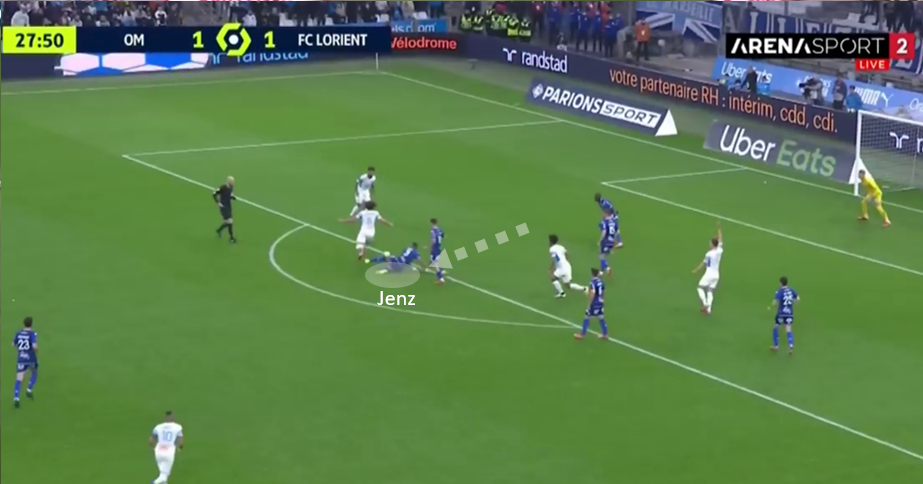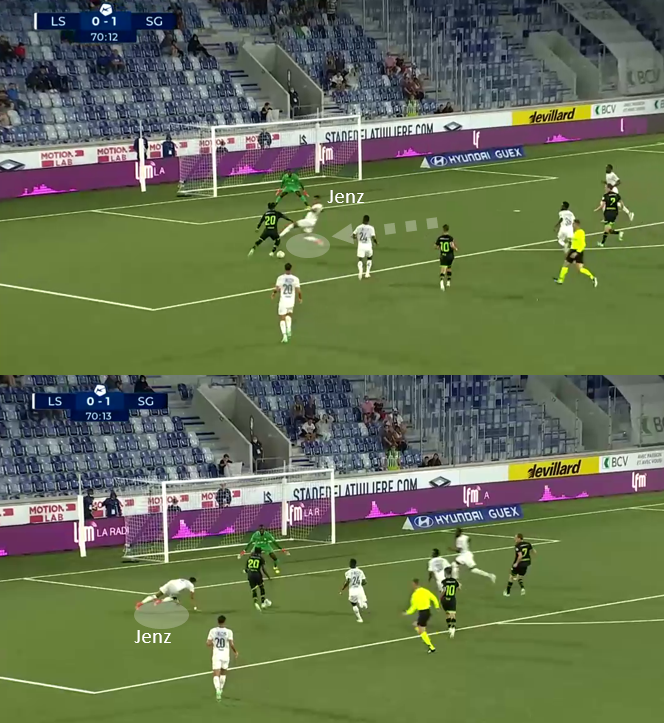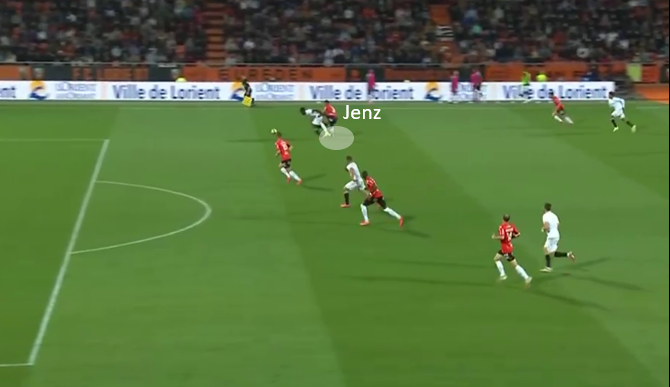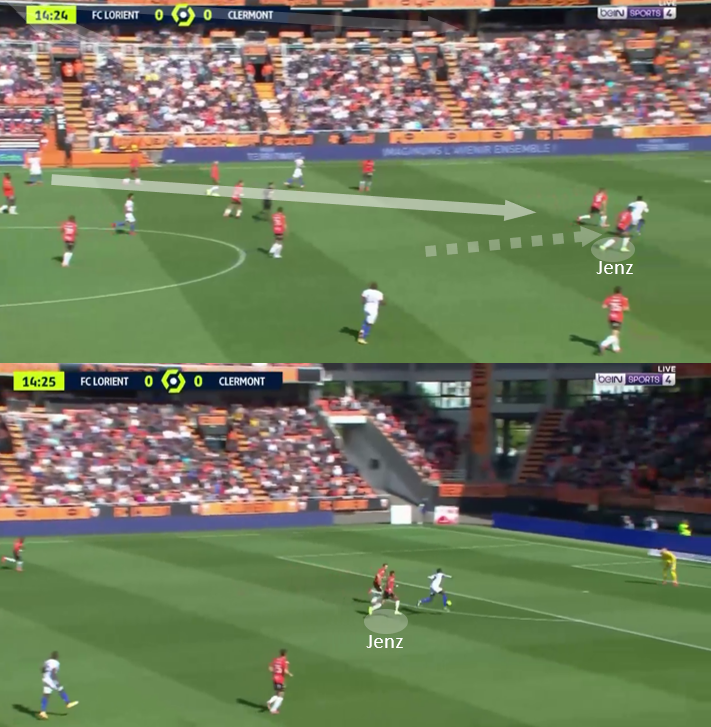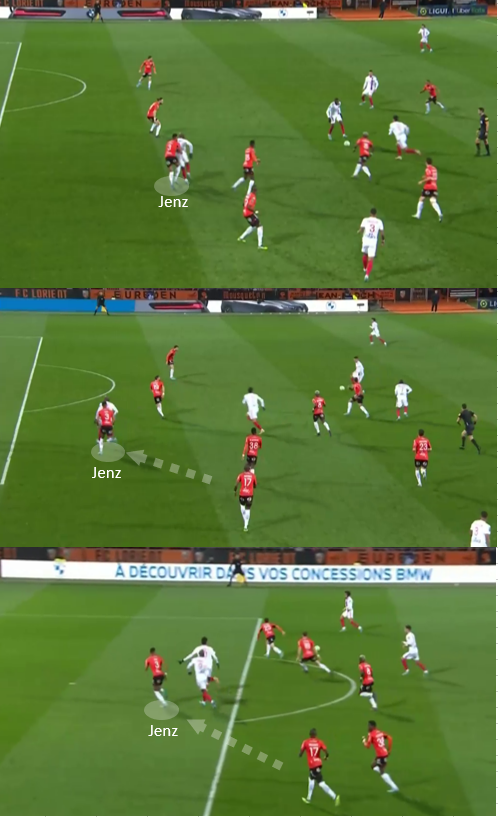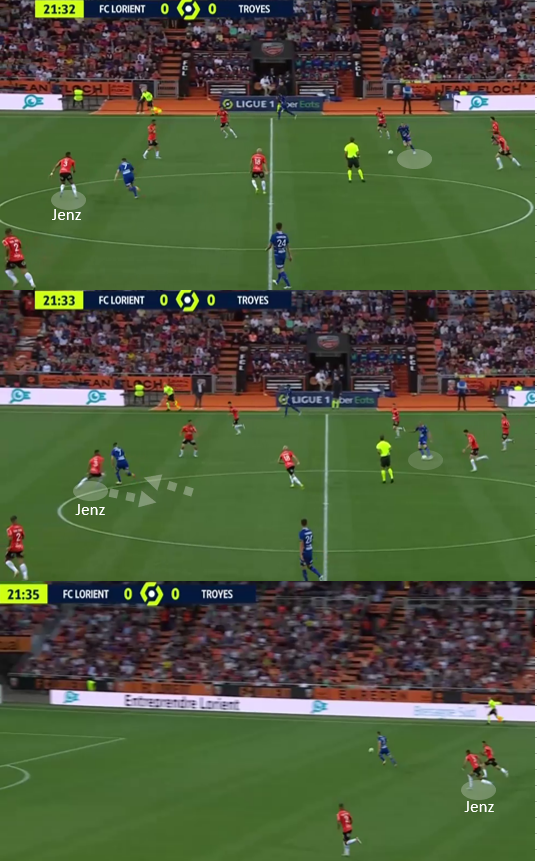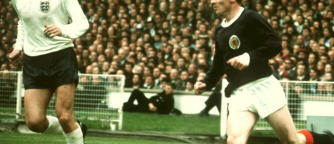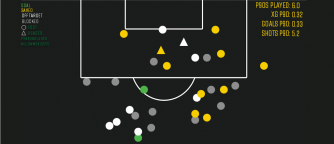The latest addition to Celtic’s backline, Moritz Jenz, has at the age of 23 still played more minutes in reserve league football than in senior leagues. Brought to the United Kingdom from Germany as a 16-year-old in 2015, he was made captain of Fulham’s under-18’s and made 50 appearances for their under-23 team in the Premier League 2.
Jenz did not get any competitive minutes for Fulham in his five years at the club, but secured a move to newly promoted Swiss top-flight team Lausanne-Sport in August 2020. After a year in Switzerland, the German moved to France with Lorient penning a five-year deal.
This analysis will cover Jenz’s time at both Lausanne and then Lorient, using The Cynic’s global stats database and extensive video breakdown to evaluate his performance and attributes before considering how he can fit into Ange Postecoglou’s system and how he compares to Celtic’s other centre-backs.
Jenz at Lausanne-Sport
Jenz quickly established himself in the first team at Lausanne, starting 26 games in the league. Of his 2,691 top-flight minutes, 76% were in games in which the the team started with a back three formation.
Being a defender for Lausanne is a very different proposition than for Celtic. In 2020/21, the team faced just over 11 shots per league game, conceding 1.4 goals on average (xG conceded also 1.4), while last season Celtic faced only around six shots per game, conceding 0.6 goals on average (xG 0.7). While Lorient made an average of 482 pass attempts per game, Celtic averaged 699 in Ange Postecoglou’s first season.
Jenz’s stats output in his single season at Lausanne showed a centre-back thriving in the system. His win % rate for aerial duels, tackles and all defensive duels combined were all within the top 20% compared to over 2,000 centre-backs globally – his tackle win rate of 79% in the top 6%.
It showed an active player defensively (not surprising in a team that finished mid-table), but also one who relied on passing to progress the ball (he was in the bottom 6% for dribbles).
With Lausanne finishing 6th, Jenz’s performance caught the eye of French Ligue 1 club Lorient, who bought the defender in the last days of the summer transfer window in 2021, among reported interest from many other clubs, including Celtic.
Jenz at Lorient
Only a year after leaving Fulham for free without a competitive senior appearance, Jenz had — at the age of 22 — secured a five-year contract in one of Europe’s top five leagues.
After going straight into the team and starting seven out of the first eight league matches in France (missing one through suspension), he was injured for five matches, before returning to start the next six. However, from the start of February, with Lorient second from bottom, he lost his place in the team, only starting three of the last 15 league games.
In the first eight games after losing his place in the team, Lorient took 14 points, cementing both their place in Ligue 1 and Jenz’s backup status within the squad. As he explained during his first press conferences when signing for Celtic on loan, this was a move and change he now very much wanted and instructed his agent to work towards. Jenz’s frustrating year can clearly be seen in his Ligue 1 stat output.
From having among the highest defensive win rates for his position, his numbers fell dramatically into the bottom third of all centre-backs. He was also giving up a high number of fouls compared to the number of duels he engaged in, also scoring low on interceptions and regaining possession.
As with Lausanne, Lorient’s place as one of the lesser teams in the league ensured a very different playing style compared to what Jenz will experience at Celtic. Lorient had an average of 40% possession in 21/22 (Celtic had 66%), with their centre-backs all averaging in the low 40s for passes per game (Jenz had 43). In comparison, Carl Starfelt averaged 92 passes in the Scottish Premiership last season.
Lorient also played predominantly with a back three, 61% of Jenz’s minutes being spent with two other centre-backs around him. At times it was a very narrow and deep three (as below) – a completely different situation to what can be expected at Celtic.
Video Analysis: Lausanne and Lorient
Passing / on the ball
Given the time and space, all of Celtic’s current centre-backs have the ability to pick out a teammate through the opponent lines – especially with the clever movement ahead of them. Last year’s backup option Stephen Welsh showed a good example of this with his pass to Reo Hatate ahead of Celtic’s goal against Legia in pre-season.
The concern has been more about the ability of the centre-backs (and goalkeeper Joe Hart) to be confident in playing through an aggressive high press; making short, sharp passes in tight spaces close to their own goal and dribbling past attackers if needed.
Does the arrival of Jenz announce a change in centre-back type, to a more naturally ‘ball-playing’ defender? In short, no.
Jenz’s time on the ball at Lausanne and Lorient will have been heavily impacted by the style of play, his teams usually having less possession than their opponents. When in time and space on the ball, Jenz does have the ability to pick out good passes through the opposition lines, as seen here against Lyon and Lille last season.
However, when pressured high in the build-up or with limited room to thread a pass, Jenz is a lot more likely to choose a ‘safer’ option. An away game against Nice in April was very revealing in this regard. On several occasions, Jenz choose not to try the riskier but playable pass to Lorient’s deep lying midfielder, Bonke Innocent.
However, late in the half he does try to reach Innocent in a similar situation, but his pass is loose and is intercepted, leading to a big chance for Nice.
Looking at all of Jenz’s passes last season for Lorient that were deemed to be in a situation where his team was being pressed, there is a clear trend of him preferring the safe option back or sideways, and he had limited success when he did go forward.
While competent on the ball, Jenz is a similar type to Celtic’s current centre-backs. He showed some signs of attempting one-touch passing across the backline to speed up play, but he usually decides against running into smaller open spaces with the ball.
Defensive duels and tackling
The ‘close-combat’ part of defending contains both Jenz’s biggest strength and weakness. As reflected in his huge variation in defensive win rates during the last two seasons, he’s an aggressive centre-back when it comes to engaging attackers, treading a fine line between winning the ball and fouling or being bypassed.
You can see the clear attraction of having Jenz in a Postecoglou backline when the ball is played up to an attacker close to him; he is very quick to step up into his opponent, giving him very little space to turn, and often nicking the ball ahead of him. When this aggressiveness comes off it looks very impressive, as in the situations below for both Lausanne and Lorient.
With Postecouglou set to have his backline even higher up the pitch this season to support a relentless and narrow press this season, Jenz’s aggressiveness could potentially be a very good fit. However, this aggressiveness can often contribute to a very high level of fouls (as reflected in his stats).
Jenz’s penchant for very aggressively jumping out against attackers was also punished several times last season, especially in quick transitions against his side. Here he moves up against the Nice attacker during a counter against and is easily bypassed, eventually leading to a shot against.
Then, in a similar situation against Bordeaux, he again gambles on reaching the ball first but is too slow, his mistake ruthlessly exploited by the opposition as they score.
Jenz’s aggressiveness can be very effective when an attacker is receiving the ball with his back against him. His major issue is that, as soon as an opponent get the space to turn and run against him, he can be look particularly exposed. This is partly because of his occasional overcommitment but Jenz is also not the quickest to adjust to a change of direction and pace. This was also evident in Switzerland where as skilled attackers would often flat-foot Jenz and get past him, even in tight situations.
Jenz’s aggressiveness also occasionally leads him to going to ground too quickly. Here he gives up an unnecessarily penalty against Nice by rushing in as opposed to staying up.
Against Marseille, instead of staying on his feet, he lunges in against the upcoming opponent, missing both ball and man in a dangerous situation.
The young defender also showed some inexperience when allowing attackers to fool him too easily in Switzerland, conceding one especially bad penalty and, in this example, diving in needlessly and aggressively when trying to prevent a 1v1 situation.
Against Nice in France, he was shown a second yellow card with Lorient 1-0 up after dragging down the attacker when caught wrong side.
When it comes to aerial duels, Jenz’s stats output again changed quite dramatically from his time in Switzerland compared to in France. Watching him play, his height and aggressiveness makes him a competent combatant in the air, especially when facing longer balls straight towards him in open play. He struggles a little more when he has to move his feet into a new position ahead of an aerial battle.
There were also a few occasions where Jenz was not able to win his headers during set-piece situations, leading to both chances and goals against Lorient last season.
Overall, the analysis of Jenz’s defensive duels and tackling over last two season is a very mixed bag, both in his actual performance but also his potential. With the right coaching and development, he could become a very effective and dominant centre-back within Ange’s system but, as seen with Lorient last season, his aggressiveness and slightly slow turn of pace can be ruthlessly exposed if he makes the wrong decisions.
Defensive positioning and recovery
Whilst his speed when turning or changing direction isn’t a strength, Jenz has good speed overall and looks to be at least on par with his new central defensive counterparts if not slightly quicker over longer distances.
At Celtic, long passes from the opposition behind the defensive line will be a lot more common with the team’s high press. While speed is an important asset for centre-back in these situations, positioning and decision-making are also key, and this led to some occasional issues for Jenz at Lorient last season.
One example was against Clermont where Jenz and his defensive partner are caught out by quite a simple high ball from out wide, with the runner in-between them going through on goal to give Clermont the lead.
Misjudging whether to hold the defensive line or fall back also caught Jenz out a few times last season. In the first example below against Lyon, he follows his runner beyond his own defensive line, allowing Lyon players the advantage in a very dangerous situation for the eventual cross.
Then against Troyes, he gambles on jumping up to set the offside line instead of dropping against his runner, again leading to another goal against Lorient. The awareness and communication between Jenz and his colleagues causing dangerous opportunities against.
Conclusion
At this time, Jenz is not likely to immediately break up the partnership of Carl Starfelt and Cameron Carter-Vickers when available, while he does seem to be slightly more mobile and a bit more comfortable on the ball than Stephen Welsh.
It’s undeniable that Moritz Jenz came to Celtic on the back of a very tough season in France. Whether it’s his numbers or from watching him play, the analysis shows a young centre-back struggling to utilise his strengths, and far too often having his weaknesses exploited.
A scouting report based only on last season would struggle to make the case for Celtic bringing him in. But, at his best in Switzerland, you can easily see the attraction; a tall, aggressive centre-half with good speed who is capable enough on the ball to contribute offensively.
Realising that inherent potential will very much come down to his ability to improve his own decision-making and quickly become comfortable in a very different system and setting than he has experienced so far in his career.



